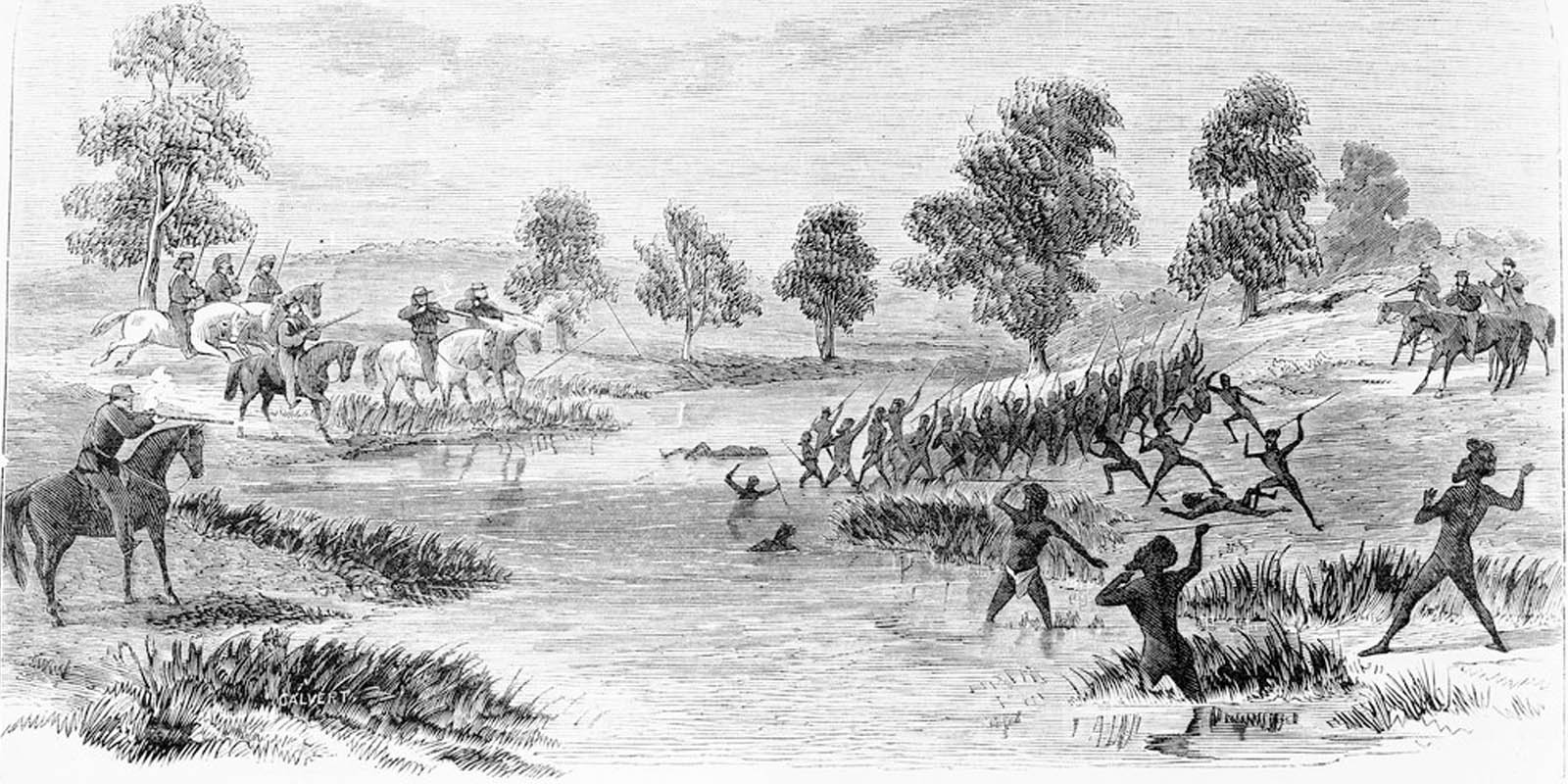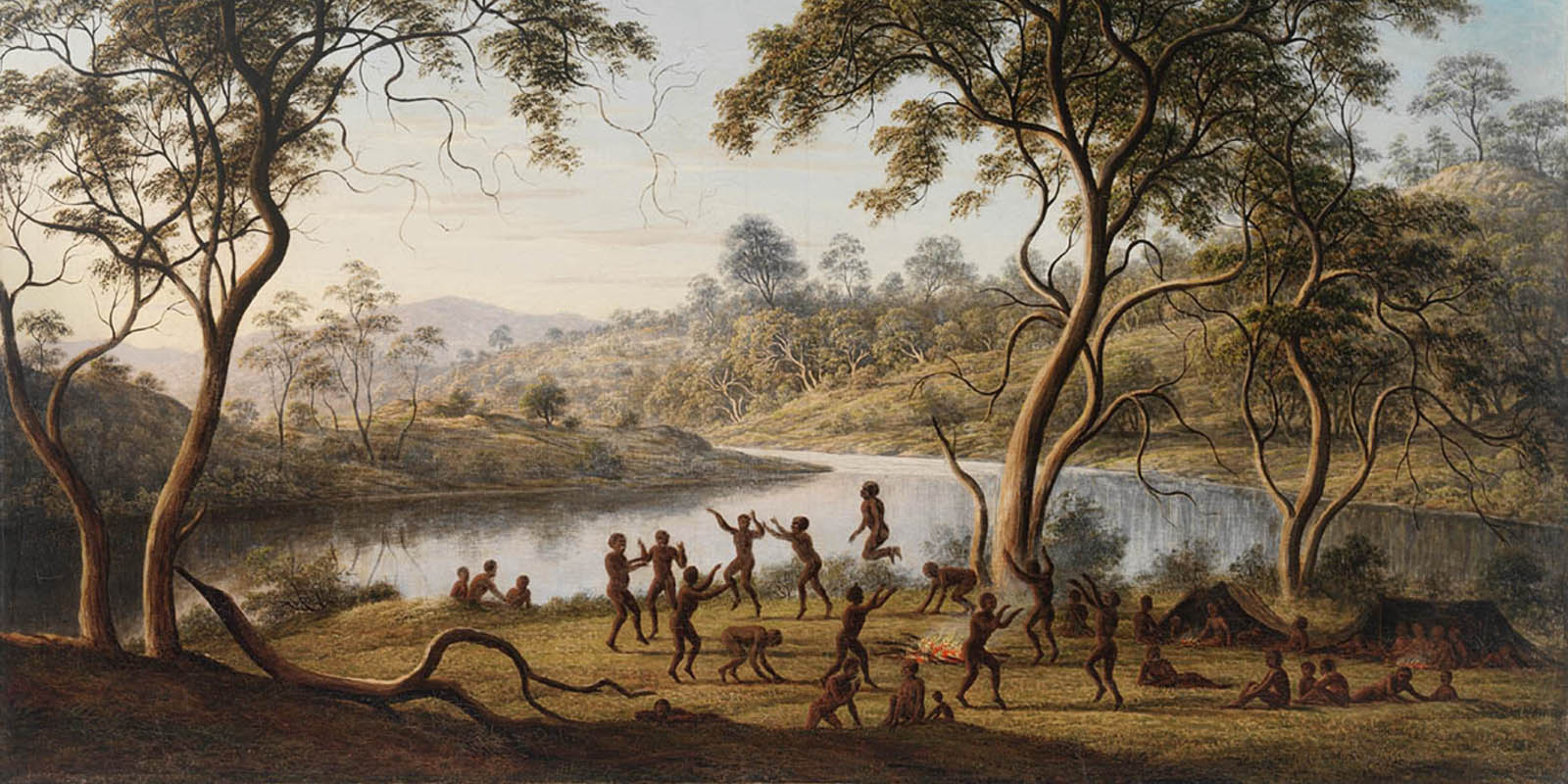This article looks at the Frontier Wars that occurred during the invasion and colonisation of what we now call ‘Australia’. We will discuss acts of oppression and violence in some detail against our people and there will be images and videos depicting the conflict. Children should speak to a trusted adult before reading.
In 1788, sometime between the 16th and 20th of January, the 11 ships that encompassed the ‘first fleet’ arrived in Sydney’s Botany Bay. On board were just over 1000 people, majority of whom were convicts and their families. They planned to begin a penal colony (settlement used to exile prisoners) that would later become the ‘Australia’ we know today. Around a week later in ‘Sydney Cove’, on the 26th January, Captain Arthur Phillip raised the Union Jack and claimed the land for Britain. This marked the beginning of the invasion and colonisation of ‘Australia’ and the many years of fighting and resistance that would occur.
An overview
The Frontier Wars refer to all the massacres, wars and instances of resistances beginning from the arrival of colonists in 1788. Officially the Wars are said to have ended as late as 1934 however many acts of violence and oppression against our community continue today, as does our resilience.
The death toll resulting from the Frontier Wars is hard to know for certain, but it is estimated that around 2000 – 5000 colonists were killed over the years while the death toll is for Aboriginal people is unknown as it is so high. In ‘Queensland’ alone it is estimated that 60,000 Aboriginal people died (the Guardian). While the true death toll for Aboriginal people across the continent is impossible to know for certain due to most of the instances being covered up or not reported, it is estimated that around 90% of the Aboriginal population prior to invasion was killed during the wars. This is a result of both colonial violence and foreign illnesses the colonists brought with them such as the flu, measles, tuberculosis and smallpox.


Conflict on the Rufus. Image Source: State Library of Victoria.
Massacres and wars
The Frontier Wars and the massacres that occurred are very rarely talked about and historically we have relied on white sources, oral history and some written documentation to prove that they occurred. However, as research continues to be done more evidence is being discovered and old evidence is being documented to ensure the history is not lost.
The University of Newcastle has created an interactive map that allows you to see and read about the many massacres that occurred after invasion which you can access here.
Below we have given brief descriptions on a few of the massacres within the Frontier Wars. Please be aware that there are acts of violence against our people being discussed and that reader discretion is advised.
For more information about invasion and warfare in Victoria, read this article.
(caution: the above video contains some course language).
The Black War (The Tasmanian War)
The Black War is one of the biggest acts of violence that occurred in the Frontier Wars.
The Black War occurred in ‘Tasmania,’ beginning in 1824 and ending 7 years later in 1831. At least 1000 Aboriginal people were killed according to official records however the actual number is most likely much higher.
Martial Law was declared by Lieutenant-Governor George Arthur. This essentially gave settlers who killed Aboriginal people immunity from any sort of legal consequence. Towards the end of the war, in late 1830 the Black Line occurred. Over 2000 colonists formed a series of offensive lines that stretched across the land and drove the Clans away from their homes and away from land the colonists had taken or wanted to take. The aim was to either kill or move Aboriginal Tasmanian people to the Tasman Peninsula in the southeast where the colonists planned to have them remain permanently imprisoned. Many died in this line as they were shot on sight if they didn’t immediately escape.
The Black War resulted in the near-destruction of all Aboriginal people living in ‘Tasmania’ due to frequent mass killings. Many of our Mob view the Black War as an act of genocide (intentional action to destroy a an ethnic, national, racial, or religious group of people). Despite this dark history, Aboriginal people have survived in Tasmania and are a strong Community today.


Image: A community in Tasmania celebrate with a Corroboree. Mitchell Library, State Library of New South Wales.
Pinjarra Massacre (The Battle of Pinjarra)
The Pinjarra Massacre occurred in 1834 in ‘Western Australia’ and was the result of an attack by colonists on a group of an estimated 80 Binjareb (also spelled Pindjarup, Pinjareb) men, women and children in retaliation to an earlier fight that left a colonist dead.
This attack was led by Governor James Stirling and a detachment of 25 colonists and they conducted the mass killing of somewhere between 15 – 30 Bindjareb people, including children.
Kilcoy and Whiteside poisonings
In 1842 in Kilcoy and in 1847 in Whiteside (both in Queensland), colonists ‘gifted’ bags of flour to the local Clans. This flour was purposefully laced with strychnine, a strong poison.
The poisonings claimed the lives of around 70 Aboriginal people in the Kilcoy district and another estimated 70 in Whiteside.
Coniston Massacre
The Coniston Massacre occurred in the Northern Territory in 1928 and is credited as one of the last mass killings by colonists during the Frontier Wars. It is said to have been the result of the death of a colonist, Fred Brooks. Two Warlpiri men were arrested and tried but were later acquitted for the death after eyewitness accounts pointed to another man as the true killer.
The man said to have killed Fred Brookes was Kamalyarrpa Japanangka. He did so after Brooks breached Warlpiri marriage lore by putting demands on Kamalyarrpa Japanangka’s wives and possibly assaulting one. A revenge party was formed, led by Mounted Constable George Murray, and over several months they shot and killed over 60 Anmatyerre, Kaytetye and Warlpiri people, includin children.
You can read more about the Coniston Massacre in this Common Ground article.


Coniston memorial plaque. Image Source: The New Daily.
Resistance
Despite the massacres, the wars and the genocide, we have survived. This is because we fought back and resisted with all we had.
There are many instances of resistance throughout ‘Australia’s’ post-invasion history and when we think of resistance fighters there are many names that come to mind. Pemulwuy was a Bidjigal man who fought against the colonists violence and theft by burning crops and raiding food stores. Jandamarra was a Bunuba man who went from police assistant to resistance fighter, leading his people against the forces invading their land. The Fighting Gunditjmara were known for fighting back and resisting the violence and invasion of their home lands.
No matter what Mob you come from you are a child of leaders, of people who fought back and resisted the violent invasion of their land and you are proof that they were successful in saving their people and their culture.
You can read more about Aboriginal resistance in our Standing Strong article.
Legacy
The Frontier Wars are still not acknowledged as official wars of our history and many of the atrocities that occurred continue to be ignored. Unfortunately, violence against our people continues today with little justice for our Mob.
Despite the many injustices we face and the pain that is inflicted on us we are still fighting, and we are still resisting. We have not given up our fight to exist in this country and we should all be proud of who we are and where we come from because of that.
Sources & Further Reading
- What are the Frontier Wars?, NITV
- The Australian Wars - SBS Documentary Series
- The Australian Wars - Learning Resources - Culture is Life
- Common Ground
- Colonial Frontier Massacres in Australia, 1788-1930, University of Newcastle
- The Killing Times, The Guardian
- 'Incarceration Nation' - Documentary - SBS On Demand.
